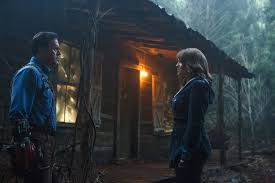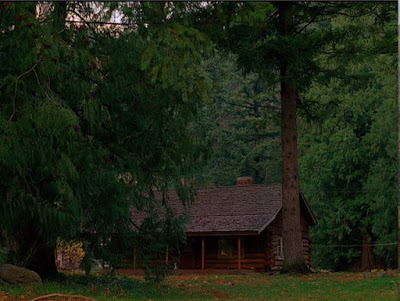Stardate: 41209.2
The
U.S.S. Enterprise-D under command of Captain Jean-Luc Picard (Patrick Stewart)
approaches the S.S. Tsiolkovsky, a Starfleet science vessel monitoring a
collapsing red giant star.
After
an “accident” which seems to kill the entire crew, an away team led by
Commander William Riker (Jonathan Frakes) investigates the situation.
What
the away team soon finds on the Tsiolkovsky is strange and unsettling. One crew
member seems to have intentionally exposed the bridge to the vacuum of space.
Meanwhile,
Lt. Geordi LaForge (LeVar Burton) enters a crew person’s quarters where the
temperature has dropped to freezing, and someone died taking a shower with
their clothes on.
The
away-team returns to the Enterprise and is decontaminated by the transporter,
but Geordi begins to show signs of a high fever, and Dr. Beverly Crusher (Gates
McFadden) worries that the Tsiolkovsky “infection” is spreading.
When
Geordi escapes from sickbay, he passes the strange disease – by touch -- to
Security Chief Tasha Yar (Denise Crosby), who soon grows lusty.
Commander
Riker recalls reading about another incident of someone showering fully
clothed, and asks Lt. Cmdr. Data (Brent Spiner) research it. The android finds
such an historical example from the Constitution class U.S.S. Enterprise commanded
by Captain James T. Kirk, nearly a century earlier. That Enterprise was also
investigating a cosmic body (a planet, not a star), undergoing radical gravity
shifts.
A
ready-made cure is sent to Dr. Crusher via the computer, from the old
Enterprise, but it doesn’t work this time.
Tasha
infects Counselor Troi (Marina Sirtis), and then Data, by engaging in sexual
contact with him. The android reports being “fully functional.”
Soon,
young Wesley Crusher (Wil Wheaton) is contaminated by Geordi, and he takes over
Engineering using a voice-synthesizer that imitates Captain Picard’s voice.
There Wesley erects a force-field around the section and refuses to let others
enter.
Disaster
looms, however, as a chunk of the collapsing star approaches the Enterprise,
and Engineering is useless…
Star
Trek: The Next Generation’s
(1987-1994) first season gets off to an extremely shaky start with this first
episode after the pilot, an homage to The Original Series (1966-1969)
hour, “The Naked Time.” In both episodes, intrepid crew members suffer from an
infection that makes them act intoxicated, or drunk, and in the process reveal
hidden aspects of their personalities.
In
“The Naked Time,” audiences witnesses Mr. Spock’s guilt and shame about not
being able to tell his human mother that he loves her. We see Mr. Sulu’s true
nature as a mad swashbuckler, unveiled. We even witnessed Captain Kirk’s almost
pathological obsession with commanding the Enterprise, and the way that this obsession
isolated him from a normal emotional life. And we also learn Nurse Chapel is
secretly in love with Mr. Spock.
Here?
In
The
Next Generation we discover that the three leading females in the
series -- Dr. Crusher, Counselor Troi, and Tasha Yar -- all have sex on their
brains.
Crusher’s
inhibitions fall and she unbuttons her uniform seductively, telling Captain
Picard that she has been denied the “comfort” of a husband for too long. Tasha
seeks sexual intercourse from Data. And Counselor Troi interferes with Riker’s
attempts to reclaim engineering, babbling that she wants to be “alone” with
him, in his mind.
There’s
absolutely nothing wrong with women characters expressing sexual interest or
desire. So let’s get that out of the way.
Women
are sexual beings, as men are, and should be able to express that in life and
in drama. However, it is rather alarming
that for “The Naked Now” the choice is made to have all the women -- when released
from their inhibitions -- express a desire, primarily, for sex. It’s insulting that there is apparently
nothing deeper to explore in these characters, beyond their desire to get it on
with the male command crew. It's as if a desire for sex is the end-all and be-all of these three career Starfleet women.
Riker,
when drunk, becomes a boring workaholic (“I can’t afford to get this!”). Geordi
longs for human sight, even though it is inferior to what his VISOR can provide
him. When he is “infected,” he doesn’t long for sex, he longs for a deeper
emotional connection to Tasha.
But
the women?
It’s all the desire for sex with the male characters, whether
Picard, Riker, or Data. I just must believe that 24th century women,
officers aboard the flagship of the Federation, would be more interesting than
that. Why are the women all defined by their sexual desire for the male
characters? Why can’t one of them be driven by ambition, like Riker, to command
a ship?
The
final line of the episode is a travesty, too.
Captain
Picard notes that the Enterprise shall have a fine crew, if it can “avoid temptation.” This is certainly a dig against the women
officers, who -- when drunk – wanted to have sex with the men, keeping them
from accomplishing their necessary life-saving tasks, essentially. The men weren’t
grappling with temptation, after all.
That
line is wrong for so many reasons.
First,
it is demeaning to the female characters, since they were the ones who acted
according to secret physical desires.
Secondly,
it makes no real sense to “avoid” temptation, given that the Enterprise is a
ship of families. If there is such physical desire, and it is mutual, why not
indulge in romantic relationships? Why not get married and have families?
At
the same time The Next Generation attempts to move forward into a world where
families can be space explorers, it seems to be mired in the 1960’s parochial
notion that one can’t be both an officer and a family man (or woman). This idea
reaches its nadir with an upcoming episode, “Haven,” wherein Counselor Troi
must choose between being a Starfleet officer and getting married.
Why
not simply have both a career and a family, especially in Star Trek’s enlightened
future? This is a notable and
embarrassing example of Star Trek: The Next Generation
(1987-1994) not being any more evolved than its predecessor had been, twenty
years earlier. It is easier to excuse the original series, being a product of
the sixties. By the 1980’s, everyone knew this kind of thinking was backwards.
Thirdly,
it is terrible that Captain Picard has to utter this line, coming across as an
arrogant prude. Why would he say this at all, knowingly embarrassing his female
bridge officers? And secondly, why is he such a shut-down prig? Between his
dislike of children and families, his near-constant surrendering of the Enterprise
(“Encounter at Farpoint,” and “The Last Outpost”), his hectoring of the crew
here, Picard isn’t yet coming across as a very capable or likable captain.
Also,
it is a terrible shame that “The Naked Now” arrives so early in the series continuity
when it is abundantly clear that the (rewritten) script has no idea what character
traits Captain Picard may be burying, or hiding from his crew.
He
becomes a goofy, skipping lapdog to Dr. Crusher, but no real inner character is
revealed. Perhaps, Picard could have revealed how he lives in fear of the day
that he knows is inevitably coming; when a child aboard the Enterprise dies
because of a choice he made.
Or
perhaps he could have revealed the guilt and shame he feels, every time he
looks at Dr. Crusher, because he is attracted to her, but he is also responsible
for the death of her husband (clearing the way for a romantic relationship).
But
“The Naked Now” lacks that level of depth.
It
lacks it in regards to Wesley Crusher too.
Being
drunk for Wesley means acting goofy, and also complaining about adults. No real
emotions or deep truths about him are broached. He’s a typical kid. What might
he feel, realistically? Resentment towards Captain Picard for the decision that
killed his father.
Perhaps,
the Enterprise could have been Jack Crusher’s ship? How does Wesley feel living
near Picard? Why give characters this
tragic, difficult background if there is no intent to exploit it in the drama?
The
way that “The Naked Now” treats Wesley Crusher is actually really terrible, and
absolutely did Wil Wheaton no favors with fans. Wesley’s behavior in the
episode, and the way it reflects on the command staff, by extension, does no character
any favors.
Basically,
the untrained genius kid saves the ship with his inventions, while intoxicated.
The
entire command crew, with the resources of the Federation flagship to command,
look inept by comparison. Wesley’s
brilliance, even under these circumstances makes fans hate him (The Will
Robinson Adric Syndrome). But the fact that a wet-behind-the-ears teenager can
save the ship, while Riker, Worf (not…even…intoxicated!), Geordi, Picard, Troi,
and Crusher can’t do so is a tough one to parse. It doesn’t say much about the
quality of Starfleet training in the 24th century.
Also
-- let’s get real -- there are over a thousand crew members on the ship. They
can’t all be sick. No one else can help
out in a pinch?
This
episode also presents the audience with the first in a series of rotating chief
engineers. Brooke Bundy plays Lt. Commander Sarah McDougal, an engineer who is
outperformed and out-smarted by an untrained civilian teenager. I remember
Brooke Bundy fondly from a guest role in Land of the Lost in the 1970’s, and
she does just fine in this episode, but McDougal’s potential as a character is
destroyed by the way this episode treats the character. The chief engineer of
the Enterprise should be the greatest engineer in the fleet. Not an
unimaginative officer who can be so easily outmaneuvered. The low point for the
character occurs when McDougal notes that something is impossible and Wesley
asks her why she can’t just see the answer in her head.
Wesley
should just become captain, chief engineer, and CMO, apparently, of this
starship Enterprise, if we are to go by the competence of the command staff in “The
Naked Now.”
In
terms of Star Trek continuity, I am of two minds regarding “The Naked
Now.” I would be lying if I said I didn’t get a kick out of hearing the name "James T. Kirk," as part of an official historical record. On the
other hand, the audience just got a great Original Series homage in “Encounter at
Farpoint,” with a lovely guest appearance by De Forest Kelley, and this is something
that shouldn’t be a pattern, as the new characters need development so badly.
The
new crew has enough problems, in this episode without reminding viewers of how
Captain Kirk handled a similar experience.
“The Naked Now” is, in the final analysis, a deeply inferior copy of a
classic, and a poor selection for an early episode.
Still, on it's own, the scene between Tasha and Data is quite wonderful.
If we don't look at as part of the pattern -- three women pining sexually for the male officers -- and just as a unique character moment between the android and the Security Chief, the scene is amusing, and returns to take on additional resonance in stories such as "Skin of Evil," "Measure of a Man," and "Legacy."
And indeed, this is one realm where The Next Generation truly excels. Instead of abandoning aspects of the series that don't work well (like the Ferengi, or Q), it returns to the characters and ideas, deepens them, and in the process, redeems them. The relationship between Data and Tasha, as viewed from a later juncture, in some way, ends up redeeming "The Naked Now."
Next
week, from bad to worse: “Code of Honor.”

























































